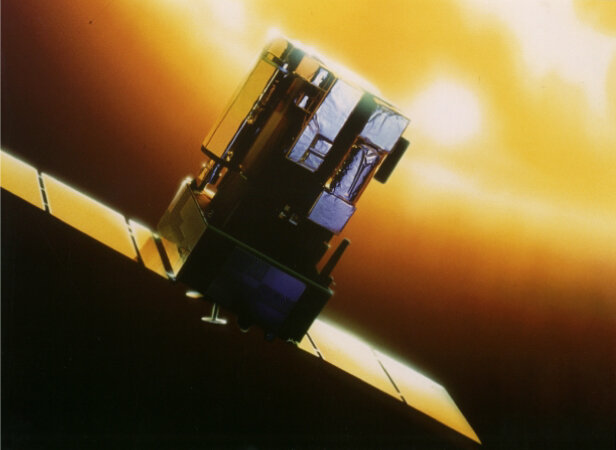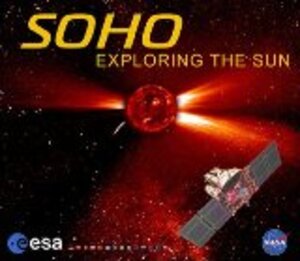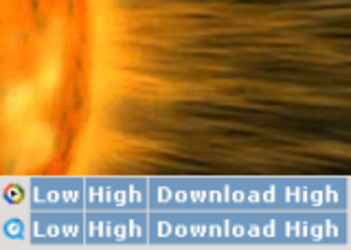SOHO operations
| ROLE | Sun observatory |
| LAUNCH DATE | 2 Dec 1995/Atlas II-AS (AC-121) |
| LAUNCH MASS | 1850 kg |
| ORBIT | First Lagrangian point (L1) between the Sun & Earth, 1.5 million km towards the Sun |
|
NOMINAL MISSION |
Approved until December 2009 |
| + SOHO is conducting the largest- and most-detailed-ever survey of solar surface features + | |
SOHO is an international collaboration between ESA and NASA. Mission operations are controlled by NASA at Goddard Space Flight Centre, Greenbelt, Maryland. SOHO contributes to the International Solar-Terrestrial Physics Programme, to which ESA, NASA, Japan, Russia, Sweden and Denmark all contribute satellites monitoring the Sun and solar effects.
Information on SOHO mission operations is presented in summary below; links to ESA's main SOHO sites are at right.
The mission
The Solar Heliospheric Observatory (SOHO) is a space-based observatory viewing and investigating the Sun from its deep core through its outer atmosphere - the corona - and the domain of the solar wind, out to a distance ten times beyond the Earth's orbit.

SOHO was built for ESA by Europe's aerospace industry, and is a joint project between ESA and NASA. Of the spacecraft's 12 sets of instruments, nine come from multinational teams led by European scientists, and three from US-led teams.
More than 1500 scientists in 20 countries are directly involved in SOHO's instruments and research programmes. NASA launched SOHO and is responsible for communications and daily operations.
Mission operations overview
SOHO was launched by NASA from Cape Canaveral Air Station, Florida, by an Atlas II-AS (AC-121) rocket, on 2 December 1995.

After a four-month journey the spacecraft reached its vantage point in orbit 1.5 million km nearer to the Sun than the Earth's own orbit. There at the Lagrange Point L1, a point in space where the gravitational pull of the Sun is balanced by the pull of the Earth and the centrifugal force acting on a spacecraft allows it to orbit in step with the Earth.
SOHO can therefore remain hovering around a stable position, relative to the Sun and Earth, in a "halo orbit," while it accompanies the Earth in its annual march around the Sun.
Some of the main tasks of the mission ground controllers are to keep SOHO pointing at the Sun and maintain its halo orbit, which takes it around Lagrange Point L1 roughly every six months. SOHO has an Emergency Sun Reaquisition routine to point it automatically at the Sun in the event of any mishap.
The ground stations

Telemetry and telecommanding are provided by NASA's Deep Space Network, using ground stations located at Goldstone (California), Canberra (Australia) and Madrid (Spain).
Control of the spacecraft was lost in June 1998, and only restored three months later through efforts of the SOHO recovery team. All 12 instruments were still usable, most with no ill effects. Two of the three on-board gyroscopes failed immediately and a third in December 1998. After that, new on-board software that no longer relies on gyroscopes was installed in February 1999. It allowed the spacecraft to return to full scientific operations.
The platform and payload

The platform
SOHO was built by industrial companies in 14 European countries, led by Matra-Marconi (now Astrium).
SOHO is a three-axis stabilised spacecraft. The service module, with solar panels, thrusters, attitude control systems, communications and housekeeping functions, was assembled in Toulouse, France. The payload module carrying the scientific instruments was assembled in Portsmouth, UK, and mated with the service module in Toulouse.
The total mass of the spacecraft at launch was 1850 kg. Its length along the sun-pointing axis is 4.3 metres, and the span of the extended solar panels is 9.5 metres.
|
Instrument |
Name |
|
CDS |
Coronal Diagnostic Spectrometer |
|
CELIAS |
Charge, Element, and Isotope Analysis System |
|
COSTEP |
Comprehensive Suprathermal and Energetic Particle Analyzer |
|
EIT |
Extreme ultraviolet Imaging Telescope |
|
ERNE |
Energetic and Relativistic Nuclei and Electron experiment |
|
GOLF |
Global Oscillations at Low Frequencies |
|
LASCO |
Large Angle and Spectrometric Coronagraph |
|
MDI/SOI |
Michelson Doppler Imager/Solar Oscillations Investigation |
|
SUMER |
Solar Ultraviolet Measurements of Emitted Radiation |
|
SWAN |
Solar Wind Anisotropies |
|
UVCS |
Ultraviolet Coronagraph Spectrometer |
|
VIRGO |
Variability of Solar Irradiance and Gravity Oscillations |















 Germany
Germany
 Austria
Austria
 Belgium
Belgium
 Denmark
Denmark
 Spain
Spain
 Estonia
Estonia
 Finland
Finland
 France
France
 Greece
Greece
 Hungary
Hungary
 Ireland
Ireland
 Italy
Italy
 Luxembourg
Luxembourg
 Norway
Norway
 The Netherlands
The Netherlands
 Poland
Poland
 Portugal
Portugal
 Czechia
Czechia
 Romania
Romania
 United Kingdom
United Kingdom
 Slovenia
Slovenia
 Sweden
Sweden
 Switzerland
Switzerland




























